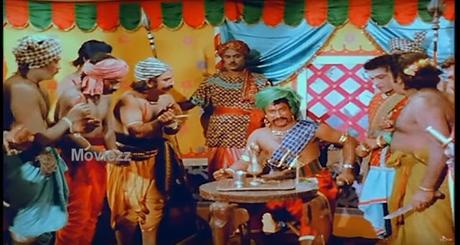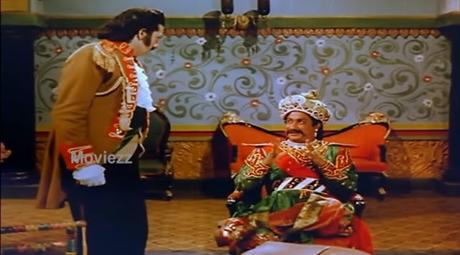
Panchalankurichi situated closer to Ottapidaram, the birth place of VO Chidambaranar and less then 20 km from Tuticorin, is a small village but has history associated with it. Veerapandiya Kattabomman lived in the 18th century, was a Palayakkarar; a local chieftain, hailed to be one of the earliest to oppose British rule. Bomman refused to accept the soverignity of East India Company; history has it that he was hanged at Kayatharu in Tirunelveli District in 1799. His brother Umai Thurai was also caught, but could escape and returned to fight the British, though eventually he was also hanged. In subsequent years, great deal of legend and folklore came to be associated with Kattabomman, Marudu brothers and the place of his execution became place of attendance. Folk songs recalling the heroism of the bommu leaders remain alive in Tamilnadu. The popular Tamil slang for a traitor or committing treason ‘Ettappan’ originated from a person by name Ettappan who was instrumental in the arrest of Kattabomman.
Kattabomman, a Nayakar was born in 1760 rose to become the King of Panchalankurichi and hanged in 1799. The meeting of Bomman with Jackson representing British is legendary, more because of a film which is ranked high in Tamil tinseldom.

கிஸ்தி, திரை, வட்டி, வேடிக்கை! வானம் பொழிகிறது, பூமி விளைகிறது! உனக்கேன் கொடுப்பது கிஸ்தி! எங்களோடு வயலுக்கு வந்தாயா? ஏற்றம் இறைத்தாயா? நீர் பாய்ச்சி நெடுவயல் நிறையக் கண்டாயா? நாற்று நட்டாயா? களை பறித்தாயா? கழினிவாழ் உழவருக்கு கஞ்சி கலயம் சுமந்தாயா? அங்கு கொஞ்சி விளையாடும் எம்குலப் பெண்களுக்கு மஞ்சள் அரைத்துப் பணிபுரிந்தாயா? அல்லது மாமனா? மச்சானா? மானங்கெட்டவனே! எதற்கு கேட்கிறாய் வரி, யாரை கேட்கிறாய் திரை? ~ powerful dialogues of Sakthi TK Krishnasamy, film’s screen play by Ma Po Sigagnanam - 1959 Tamil film “Veerapandiya Kattabomman” directed by B. R. Panthulu. Everybody aspiring to become an actor would try to repeat those immortal dialogues uttered by Sivaji Ganesan. It was released in Telegu Veerapandiya Kattabrahmanna and in Hindi as Amar Shaheed ..
Those of us, no great followers of Cinema would have had a feeling that it was perhaps some hype about a local chieftain .. .. .. .. remember, whatever we read as Indian history is that written by Britishers, at time their version of what they saw and at times what they wanted the Nation to be ! - here is something excerpted from a book published at Government Press in 1879.
Tinnevelly may be considered as an epitome, or facsimile on a miniature scale, of the whole Madras Presidency, almost every feature of which is repeated on a smaller scale within this little area. In the last century (reference to 1700s) the plains of Tinnevelly are represented as covered with woods and jungle ; these have disappeared with the advance of agriculture to so great an extent, that beyond avenues on the main roads…… the village system of India is one of the most remarkable features of Indian civilization. Grenerally the civilization of the Hindus is inferior to our own, but in some particulars it is in advance of ours ; and one which it claims the advantage is the fact that every Hindu village is an organized municipality. The greater number of English towns and all English villages are mere collections of houses without any bond of connexion or corporate life, without rulers, without office-bearers, and without any organization for the preservation or advancement of the common interests. In India, on the contrary, every village of any respectability is an incorporation. It has its council of headmen, its rights of jurisdiction, its revenues, and its meetings for the transaction of public business. The municipality ordinarily makes itself responsible for the settlement of disputed claims by arbitration, for the punishment of petty offences, and for the preservation of the peace.
There have been many rulers in this part of land, around the 15th century it was Pandyan dynasty, then Nayakas, as the Vijayanagara Telugus were called. Madura was fortified Nayakas; the constitution of the Poligars, ancestors of present Zemindars of Tinnevelly and Madura, is assigned by tradition to Visvanatha Nayaka, and was by far the most important political event of the time. The rulers of Nayaka race are enumerated by Nelson in his Manual of Madura as having borne sway over Madura and Tinnevelly between 1559 and 1736. There was Thirumala Naika engaged in exhausting wars. Then came Queen regent Mangammal (from 1689 to 1704), who ruled as regent during the minority of her grandson.
The regions were to witness wars and bloodshed. In 1755, at the request of the Nawab a force of 500 Europeans and 2,000 sepoys was ordered to proceed to the countries of Madura and Tinnevelly. The whole force was commanded by Colonel Heron. The renters, both of the capital and of the open country, acknowledged the Nawab without hesitation, but many of the neighbouring Poligars made pretences to evade the payment of tribute due, The most considerable of these was Kattaboma Nayakan, Poligar of Panjalamkurichi, near the present town of Ootapidaram. An expedition was sent to reduce him, but had to be recalled as the whole force was obliged to return to Trichinopoly. On the way back a Poligar fort at Nelikotah is said to have been stormed and taken, and almost all tho garrison put to the sword in the heat of the attack.
While returning, Colonel Heron was induced to turn aside and attack the fort of Nellitangaville, now Nikkatansewal, a small estate, but held by a chief known as the Puli Devar, whose influence over all the western Poligars was great, and who gave the English much trouble. For want of cannon and of supplies and pay, the attack had to be abandoned. Colonel Heron, who had himself accepted large presents, was recalled to Madras, tried by court-martial, and dismissed !
Years later, British by means of cessions of territory, persuaded the Poligar of Ettiapuram and Kattaboma Nayakan of Panjalamkurichi to assist him, and a great battle was fought about seven miles north of Tinnevelly, where the Puli Devar and his allies were completely defeated and fled each to his stronghold. Encouraged by the Dutch, who were at this time in possession of Colonel Colombo and Tuticorin, and with whom Kattaboma Nayaka had made a treaty, all the Poligars of Tinnevelly were now in rebellion, in 1783, ravaging the Grovernment lands as well as fighting one with another. Colonel Fidlarton, to whom the command of the expedition was entrusted, determined to strike a sudden blow, and marched over seventy miles, from Shivaganga to Panjalamkurichi, the fort of Kattaboma Nayaka.
The book also records that Kattaboma Nayaka of Panjalamkurichi, when summoned to attend the cutcherry of Mr. Jackson, Collector in 1798, had rushed out on pretense of alarm, and is believed with his own hand to have stabbed Lieutenant Clarke, who was on guard outside. He and the other Poligars paid no attention to orders received from Mr. Jackson and Mr. Lushington, who succeeded to the office of Collector in 1798 ; but employed themselves in committing depredations and disturbing the tranquillity of the country by murdering the peaceable inhabitants. Their mutinous conduct was passed over by the Government until the fall of Seringapatam in 1799 set free sufficient troops to make sure of success. An expedition was then organized and placed under the command of Major Bannerman, and the first Poligar war, as it is called, followed.
The campaign lasted but two months, in 1799. Later Major Bannerman arrived at Panjalamkurichi, tried to storm the fort but was unsuccessful. The Poligar did not wait for a renewal of the attack, but evacuated the fort with all his party. In another war, Kattaboma escaped first to Shivaganga and then to the Tondiman. Tliirty-four of his Political principal adherents, especially his principal manager Suibramania Pillai, were however taken, and hanged. Sundara Pandya Nayaka, brother of the Poligar of Nagalapuram, who had headed a plundering and murdering expedition into Ramnad, was also hanged. Kattaboma Nayaka himself captured by the Tondiman Rajah, was sent to Major Banneraian, by whom he was tried by court martial and hanged at Kaitar in presence of the Poligars of Tinnevolly assembled for the purpose.
After the execution of Bommu and his dumb brother, the fort of Panjalamkurichi was razed to the ground, the site ploughed over and cultivated. Thus ended the second and last Poligar war.
With regards – S. Sampathkumar 3rd Jan 2017.
Biblio : A Manual of the Tinneyelly Dist in the Presidency of Madras Compiled by AJ Stuart, MCS, Acting Dist Judge Coimbatore
Printed by E.Eyes Government Press 1879.

